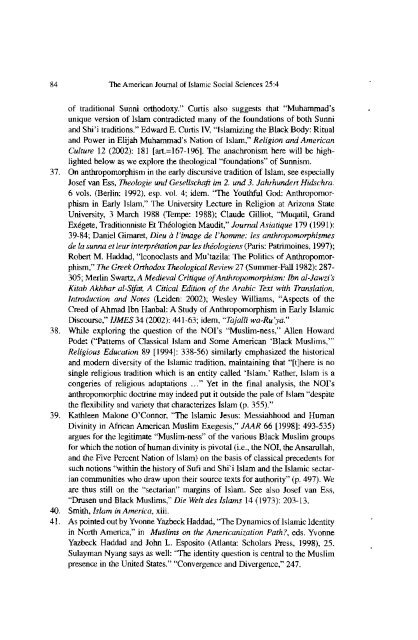Black Muslim Theology and the Classical Islamic Tradition ...
Black Muslim Theology and the Classical Islamic Tradition ...
Black Muslim Theology and the Classical Islamic Tradition ...
You also want an ePaper? Increase the reach of your titles
YUMPU automatically turns print PDFs into web optimized ePapers that Google loves.
84 The Amerlcan Journal of Istamic Social Sciences 25:4<br />
of traditional Sunni orthodoxy." Curtis also suggests that "Mohammad's<br />
unique version of Islam contnltlicted many of <strong>the</strong> foundations of both Sunni<br />
<strong>and</strong> Shi'i traditions." Edward E. Curtis IV, "Islamizing <strong>the</strong> <strong>Black</strong> Body: Ritual<br />
<strong>and</strong> Power in Elijah Mohammad's Nation of Islan1." Religion <strong>and</strong> American<br />
Culture 12 (2002): 181 [art.=167-196]. The anachronism here will be highlighted<br />
below as we explore <strong>the</strong> <strong>the</strong>ological "foundations" of Sunnism.<br />
37. On anthropomorphism in <strong>the</strong> early discursive tradition of Islam, see especially<br />
Josef van Ess, Theologie und Gesellschafl im 2. und 3. JahrhuJU1en Hidschra.<br />
6 vols, (Berlin: 1992), esp. vol. 4; idem. "'The Youthful God: Anthropomorphism<br />
in Early Islam," The University Lecture In Religion at Arizona SUlte<br />
University, 3 March 1988 (Tempe: 1988); Claude Gilliot, "Muqatil, Gr<strong>and</strong><br />
Exegete, <strong>Tradition</strong>niste Et Theologien Maudit," Journal Asiatique 179 (1991 ):<br />
39-84; Daniel Gimaret, Dieu al'image de l'lwmme: les anthropomorphismes<br />
de la sunna et leur interpretation par les <strong>the</strong>ologiens (paris: Patrimoines, 1997);<br />
Robert M. Haddad, "Iconoclasts <strong>and</strong> Mu'tazlla: The Politics of Anthropomorplrism,"<br />
The Greek Ortlwdox Theological Review 27 (Summer-Fall 1982): 287<br />
305; Merlin Swartz,A Medieval Critique ofAnthropamorphism: Ibn aJ-Jawzi's<br />
Kitab Akhbar al·Sifat, A Citical Edition of <strong>the</strong> Arabic Text with Translation.<br />
Introduction <strong>and</strong> Notes (Lelden: 2002): Wesley Williams, "Aspects of <strong>the</strong><br />
Creed ofAhmad Ibn Hanbal: A Study of Anthropomorphism in Early <strong>Islamic</strong><br />
Discourse," lJMES34 (2002): 441-63; idem, "Tajalli wa-Ru·ya."<br />
38. WhIle exploring <strong>the</strong> question of <strong>the</strong> NOrs "<strong>Muslim</strong>-ness," Allen Howard<br />
Pode: ("Patterns of Dassiea1 Islam <strong>and</strong> Some American '<strong>Black</strong> <strong>Muslim</strong>s:"<br />
Religious Edu£ation 89 [1994]; 338-56) similarly emphasized <strong>the</strong> historical<br />
<strong>and</strong> modem diversity of <strong>the</strong> <strong>Islamic</strong> tradition, maintaining that "[t]here is no<br />
single religious tradition which is an entity called 'Islam.' Ra<strong>the</strong>r, Islam is a<br />
congeries of religious adaptations .. ." Yet in <strong>the</strong> tlnal analysis, <strong>the</strong> NOrs<br />
anthropomorphic doctrine may indeed put it outside <strong>the</strong> pale of Islam "despite<br />
<strong>the</strong> flexibility <strong>and</strong> variety that characterizes Islam (p. 355)."<br />
39. Kathleen Malone O'Connor, "The lslarrric Jesus; Messlahhood <strong>and</strong> Human<br />
Divinity in African American <strong>Muslim</strong> Exegesis," JAAR 66 [1998]: 493-535)<br />
argues for <strong>the</strong> legitimate "<strong>Muslim</strong>-ness" of <strong>the</strong> various <strong>Black</strong> <strong>Muslim</strong> groups<br />
for which <strong>the</strong> notion ofhuman divinity is pivotal (i.e., <strong>the</strong> NOl, <strong>the</strong> Ansarullah,<br />
<strong>and</strong> <strong>the</strong> Five Percent Nation ofls1am) on <strong>the</strong> hasis ofclassical precedents for<br />
such notions "within <strong>the</strong> history ofSufi <strong>and</strong> Shi'i Islam <strong>and</strong> <strong>the</strong> Islarrric sectarian<br />
communities who draw upon <strong>the</strong>ir source texts for authority" (p. 497). We<br />
are thus still on <strong>the</strong> "sectarian" margins of Islam. See also Josef van Ess,<br />
"Drusen und <strong>Black</strong> <strong>Muslim</strong>s," Die Welt des Islams 14 (1973); 203-13.<br />
40. Smith. Islam in America. xiii.<br />
41. As pointed out by Yvonne Yazbeck Haddad, "The Dynamics of<strong>Islamic</strong> Identity<br />
in North America;' in <strong>Muslim</strong>s on <strong>the</strong> Americaniwtion Path?, eds. Yvonne<br />
Yazbeck Haddad <strong>and</strong> John L. Esposito (AtJanUl; Scholars Press, 1998), 25.<br />
Sulayman Nyang says as well: "The identity question is central to <strong>the</strong> <strong>Muslim</strong><br />
presence in <strong>the</strong> United States." "Convergence <strong>and</strong> Divergence," 247.
















